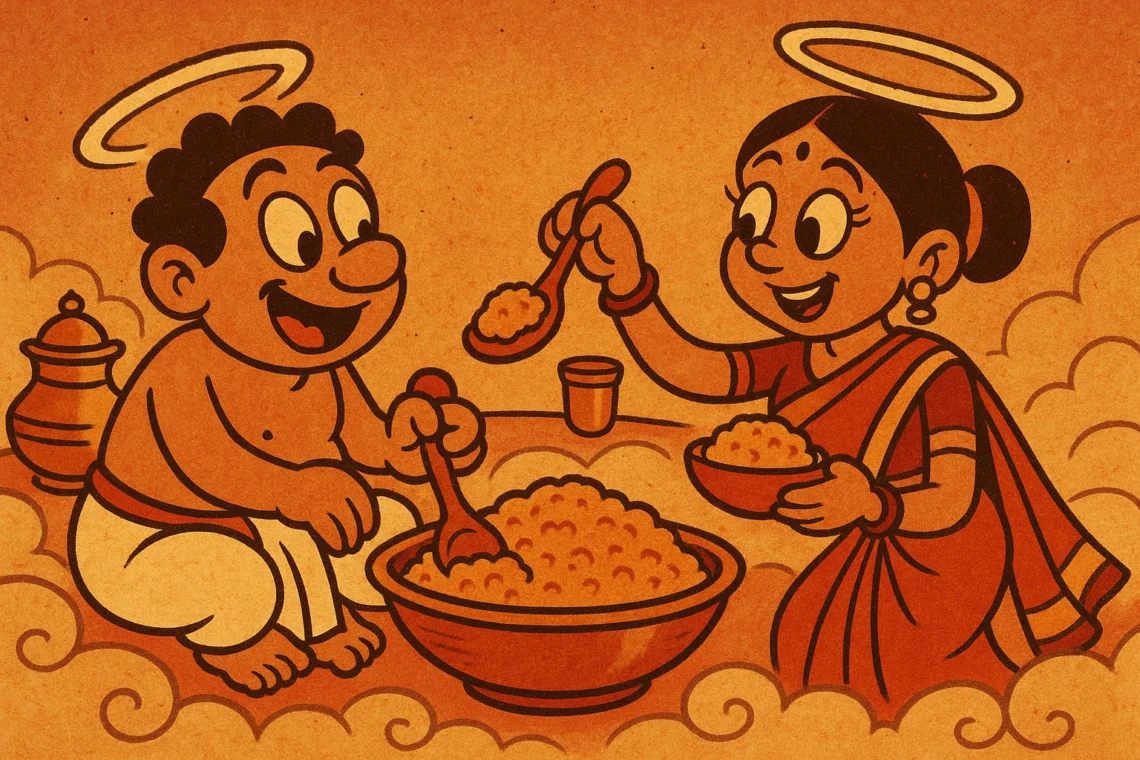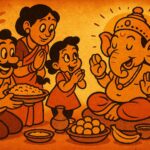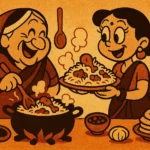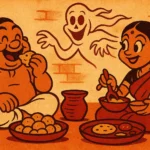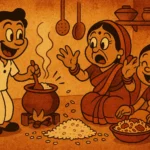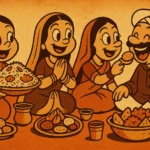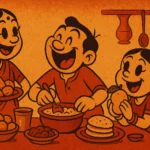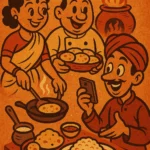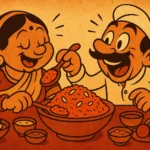As a child, I would often hear stories from my grandmother about the afterlife. These weren’t your usual tales about clouds, harps, and angels. No, my grandmother’s version of the afterlife was deeply rooted in the flavors and textures of the world she knew best—Indian food. The afterlife, in her stories, was filled with halwa, puris, laddoos, and endless platters of food so rich that they could feed every soul forever. And if you’ve ever tasted a bowl of gajar ka halwa, you’ll understand exactly why those stories felt so real to me.
In Indian mythology, food isn’t just about sustaining life; it’s also about ensuring that the soul is nourished in the afterlife. The connection between food and the divine is woven deeply into our cultural fabric, and that extends to what we imagine heaven might look like. In Indian stories, food isn’t just something to fill our stomachs—it’s a symbol of divine favor, an offering, and a comfort for the soul, even after death.
Heavenly Feasts: What We Eat When We Leave This World
In Indian stories and myths, food plays an essential role in the afterlife. One of the most iconic examples is the portrayal of *swarg* (heaven) as a place where food never runs out. In Hindu mythology, the gods live in paradise surrounded by the finest foods—sweets made of the finest ghee, fruits that grant immortality, and meals so rich that even the gods can indulge without consequence. If you’ve ever imagined heaven as a sort of eternal buffet, full of indulgent, comforting foods, then you’re not alone. Indian mythology paints a similar picture, with food serving as a metaphor for divine abundance and eternal bliss.
Take the concept of *amrit* (nectar of immortality), for example. In the myth of the churning of the ocean (*Samudra Manthan*), the gods and demons churn the ocean to extract the nectar, which is said to grant immortality. This nectar is not just a drink—it’s a symbol of the divine food that sustains both the gods and the universe itself. This concept suggests that the afterlife, much like the life we lead on Earth, is filled with the pleasures of eating and the eternal enjoyment of food. In this case, food becomes something that transcends mere physical nourishment; it becomes a representation of eternity and spiritual sustenance.
Food as a Symbol of Divine Favor
In many stories, food plays a symbolic role as an offering to the gods. The offerings made during religious rituals, including the sweet offerings of halwa, rice, and fruits, are not just acts of worship; they are a way of nurturing the soul. When the soul departs, these offerings are said to be received by the gods in the afterlife, where the deceased is not only cared for but also continuously nourished with the finest food. Whether it’s the famous *prasad* offered at temples or the cooked food sent to ancestors during festivals like *Pitru Paksha*, food is seen as a way to ensure that those who have passed continue to feel the comfort and care of the living world.
For example, during the festival of *Karva Chauth*, women fast all day to pray for the long life of their husbands. After the fast, the first bite of food they eat, usually given by their husbands, is considered sacred, and it’s believed that this act of breaking the fast is an offering of love and devotion. In the afterlife, this symbolism continues. In Hindu belief, the departed soul is often offered food, but instead of being nourished in a physical sense, the soul receives food for its spiritual well-being—a kind of nourishment that ensures the soul’s journey is fulfilled with care and protection.
Gajar Ka Halwa and the Eternal Comfort Food
In many ways, food in Indian afterlife stories mirrors the food we consider comforting here on Earth. My grandmother often told me that in heaven, they didn’t just serve fancy feasts—they served *halwa*. Whether it was gajar ka halwa (carrot pudding) or moong dal halwa, the comfort of a warm, sweet dish was always emphasized. And why not? Halwa is a dish that brings warmth, familiarity, and joy. It’s made with ghee, sugar, and spices like cardamom, which aren’t just ingredients—they’re symbols of the love and care that goes into making something special. Imagine that same halwa being served in heaven, a perfect blend of warmth and sweetness that comforts the soul just as much as it does the body.
In stories of the afterlife, halwa is often portrayed as one of the main offerings, symbolizing the joy of the afterlife, the divine satisfaction that comes from being in the presence of the gods. The story of food in these myths isn’t just about eating; it’s about the emotions that come with food—the love, the generosity, the care. Just as we gather around the table in this life, sharing a meal that nourishes both body and spirit, in the afterlife, food is the ultimate symbol of connection and continuity.
Food in Dreams: The Afterlife’s Offerings
Even beyond mythology, food’s role in the afterlife carries a deep significance in dreams and personal experiences. In many cultures, including in India, the food we dream of can represent desires, comfort, and unresolved emotions. When food appears in dreams, especially in the context of the afterlife, it can be a sign of the soul’s need for nourishment or a message from loved ones who have passed on. I remember a dream from my childhood where I saw my grandfather, smiling and offering me a plate of his favorite *kheer*. It wasn’t just food in that moment—it was a connection to him, a sign that his spirit was well and truly at peace.
Food in these dreams isn’t meant to be understood as literal; rather, it’s a representation of care, connection, and love that transcends the physical realm. It’s the kind of nourishment that can’t be explained in earthly terms. Just like the halwa served in heaven, food in these dreams represents something eternal—something that sustains us even after death. Whether it’s the fragrance of spices or the sweet taste of *mithai*, food in the afterlife becomes a language of the soul, speaking to us in ways that words can’t.
The Magic of Food Beyond Life
In the end, the afterlife food stories of Indian mythology are about more than just the ingredients or the meals themselves. They are about how food connects us to the divine, how it ties the living and the dead, and how it brings comfort in ways that go beyond the physical. Whether it’s the lavish feasts of the gods or the humble offerings of halwa and rice, food in Indian afterlife stories symbolizes nourishment for the spirit. It’s the idea that food can transcend the earthly realm, offering us a sense of peace, love, and continuity. And perhaps, in that magical world where the soul finds solace, there’s always a plate of halwa waiting to comfort us, just as it always has.
Born in Mumbai, now stir-frying feelings in Texas. Writes about food, memory, and the messy magic in between — mostly to stay hungry, sometimes just to stay sane.

